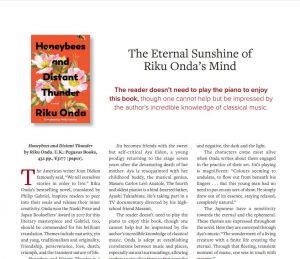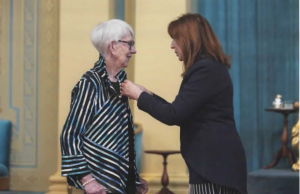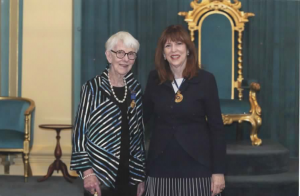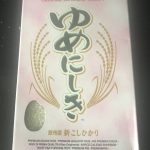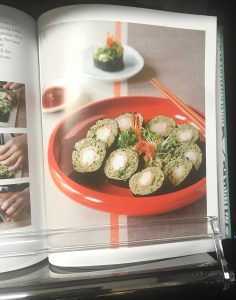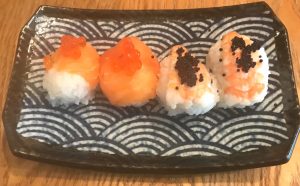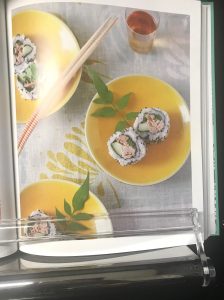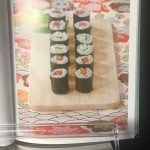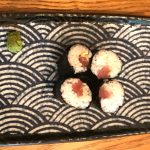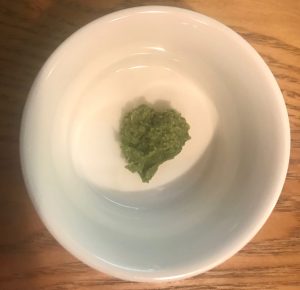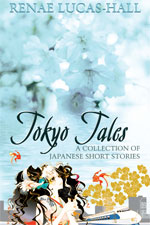Stylish “Sushi at Home” with Yumi Gomi’s Cookbook
I just spent a delightful weekend making all kinds of stylish sushi from Yuki Gomi‘s popular cookbook, “Sushi at Home: The Beginners Guide to Perfect, Simple Sushi“. For years, I’ve been making the same sushi but now I’ve learned all sorts of wonderful, innovative alternatives.
I was able to make this sushi with the generosity of the following online shops: The Wasabi Company kindly sent me this cookbook along with some ingredients, including some fantastic Wasabi Powder and Ma Kombu, to enhance my sushi rolling extravaganza. The Japanese Shop, based in Harrogate in the UK, sent me some beautiful Seikaiha Oblong Japanese Sushi Plates, Blue Cherry Blossom Japanese Chopsticks, and Seikaiha Japanese Traditional Chopstick Rests. I’m in love with their tableware. The photo of these plates below does not do them justice. The quality is superb. Finally, The Fish Society, the UK’s premier online fishmonger, sent me their Sushi Kit including salmon, tuna, and prawns (definitely the best fish for sushi I’ve ever tasted) as well as their Sushi Accessory Kit which came in handy.
I used Yumenishiki short grain rice from the Kombini shop in Gloucester and I added a piece of Ma Kombu dried seaweed from The Wasabi Company to the rice cooker before steaming to add nutrients and improve the flavour.
Now let’s get to the sushi! I’m starting with the most stylish sushi I’ve made to date. That’s the “Kani and Ebi Oshi Sushi (Crabmeat and king prawn mini pressed sushi) on page 97. This was so easy to put together and as you can see in the photo below it looks impressive! Yuki Gomi gives you all the instructions you need to make this simple and appetising sushi. She also says it’s popular because it looks like a cupcake!
After flicking through the cookbook, I was really excited to try the Soba Sushi pictured on page 115 so it was one of my first attempts. I thought it was going to be a failure when the soba started sticking together but I followed Yuki’s advice and added a touch of oil, and that solved the problem. Yuki trained under master noodle chef Mr Sekizawa in Japan so she really knows what she’s doing. I followed her Ebi Tem Cha-Soba Sushi (prawn tempura and soba-noodle sushi) recipe on page 113 but I didn’t fry the prawns in tempura batter because of time constraints. This unique sushi was surprisingly nice. I’d definitely make it and eat it again.
Next, I was excited to try this temari sushi (hand-ball sushi) pictured below from pages 92-93. I used smoked salmon from Waitrose to make the Oyako Temari Sushi (smoked salmon and salmon roe hand-ball sushi) from page 88. It looks pretty and tastes delicious. I also used the prawns sent to me from The Fish Society to make Ebi Temari Sushi (prawns with lumpfish roe hand-ball sushi) featured on page 86.
After this, I made Ura Futomaki (giant inside-out rolls), the modern version of the classic futomaki (giant rolls). I’ve eaten this many times in conveyor belt sushi restaurants but I was always too afraid to make it at home. Yuki’s cookbook helped me get over this fear and I was surprised at just how easy this was to make. I think that’s because all the rice on the outside of these inside-out rolls sticks together and holds everything in place. Below is the Kaisen Ura Futomaki (tuna, salmon, and avocado with black lumpfish roe (I couldn’t get the red small fish roe)) pictured on pages 62 and 63. This is my favourite sushi from the weekend but Yuki’s version definitely looks better!

My next attempt at a different inside-out sushi was the Tuna Salad Ura Futomaki (poached tuna wasabi mayo, cucumber, and rocket leaves with sesame seeds or black lumpfish caviar) from page 65. My husband Roy liked this one the best. But, I forgot to add the cucumber!
Most Westerners love the traditional futomaki (giant roll) with the nori seaweed sheet on the outside so I decided to make it but I should have been more generous with the salmon, the chives, and the crab meat. I followed Yuki’s recipe for Classic Seafood Futomaki (salmon, crabmeat, avocado, and chives giant roll) from page 54.
I love inari sushi (featured on page 121)! This version is shop-bought braised abura-age tofu pockets in a sweet soy sauce that you have to gently pry open to add rice and then top with seasonings. They’re so good. It’s hard to stop at one!
I prefer traditional sushi to the Californian variety so I was looking forward to making some Kappa Maki (cucumber roll) on page 30 and Tekka Maki (tuna and wasabi small roll) on page 31. I also made oshinko maki with yellow pickled daikon because I like the way it adds colour to the plate. I used the Sanpuku Nori sheets from The Wasabi Company to make these. The taste and texture of this nori are excellent but they didn’t stick well together in the rolling process so I reverted to using the Yutaka Sushi Nori sheets from The Fish Society. My presentation and rolling ability also need a lot of improvement!
I always like some miso soup to complement the sushi and Yuki Gomi has an easy-to-follow recipe for clam soup on page 142. I picked up some delicious True Tide White Shell Clams from Waitrose and I bought some white miso paste from the Kombini shop in Gloucester. If you’ve never made miso soup before my suggestion is to put a tablespoon of miso paste into a ladle. Dunk this into the boiling water with the clams and the dashi and gradually stir boiling water into the miso in the ladle with long chopsticks and allow this to slowly merge with the boiling water in the pan.
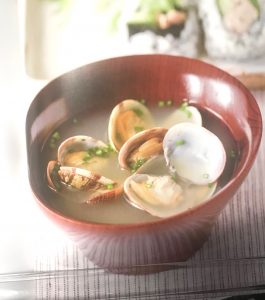
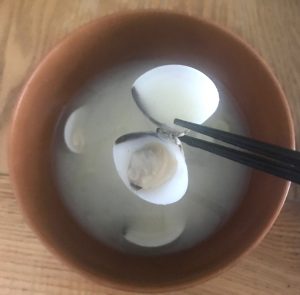
The Fish Society Sushi Kit with the salmon, tuna, and prawn goes a long way so I had some leftover fish and I decided to make the Classic Kaisen Chirashi Sushi (seafood chirashi sushi) recipe on page 104. I added omelette chunks from Yuki’s tamagoyaki recipe on pages 50 and 51. I think it looks marvellous on the plate and the variety of fish in this gourmet version was mouthwateringly good.

I also made maguro nigiri (tuna nigiri) to savor the last of the tuna fish.
Below are photos of the salmon and tuna The Fish Society sent me. This is a top-quality Coho Salmon Belly Sashimi Strip and a top-quality Tuna Sashimi Grade Maguro Saku block. The salmon was buttery and incredibly smooth, the tuna was mild but tender, and the taste and texture of this sushi-grade fish was superlative to anything I’ve had in the past. If you want to make the best sushi possible in the UK it has to come from The Fish Society.
The wasabi (Japanese horseradish) I used to accompany this sushi was made using Wasabi Powder from The Wasabi Company. You simply add water to the powder and it makes the most delicious wasabi with a wonderful sharp taste. This online retailer also sells fresh Japanese Wasabi and Wasabi Plants.
I highly recommend this cookbook and after making all this sushi, I discovered that Yuki Gomi has a website and she’s committed to the art of cooking and sharing this with others.

“Yuki Gomi is a Japanese chef, food writer, and cookery teacher. Her mission is to educate and share just how simple, nourishing, and delicious Japanese food can be.
Through her writing and Japanese cooking classes, Yuki wants to share the joy of Japanese cooking by fusing traditional and modern techniques to create accessible, healthy, and exciting Japanese food. As a professionally trained chef and author of Sushi at Home, published by Penguin, she teaches Japanese cookery from her kitchen in London, giving the skills and techniques to students wanting to cook Japanese food at home.” — Yuki Gomi’s website
“Sushi at Home: The Beginners Guide to Perfect Simple Sushi” is available from The Wasabi Company. 175 pages. Penguin Group. £16.15
My Cherry Blossom Stories Collection
If you love Japan and reading you’ll enjoy my books. They’re available from Amazon and most online retailers.
Kyoto Journal’s “Cultural Fluidity” Issue and My Review of Honeybees and Distant Thunder
Kyoto Journal’s latest issue, “Cultural Fluidity”, is now available to download.
Overflowing with captivating content, Magda Rittenhouse‘s poignant piece on Ryuichi Sakamoto, the “godfather of electronic music”, brought tears to my eyes. Li Zizi’s Chinese flower paintings are breathtaking. There are also compelling features on jazz, punk music, and the rich history of Noh and the new “Noh”. This issue is a delight to explore. You’ll enjoy reading articles exploring Japanese emoji meanings, profound reflections on Nikkei community experiences, and haiku, as well as fantastic reviews courtesy of Patrick McCoy, Leanne Ogasawara, Kala Ramesh, David Cozy, and other esteemed writers. Trust me, this issue is a must-read gem.
My review of ‘Honeybees and Distant Thunder’ by Riku Onda is on page 114. Here’s a snippet of that review:
